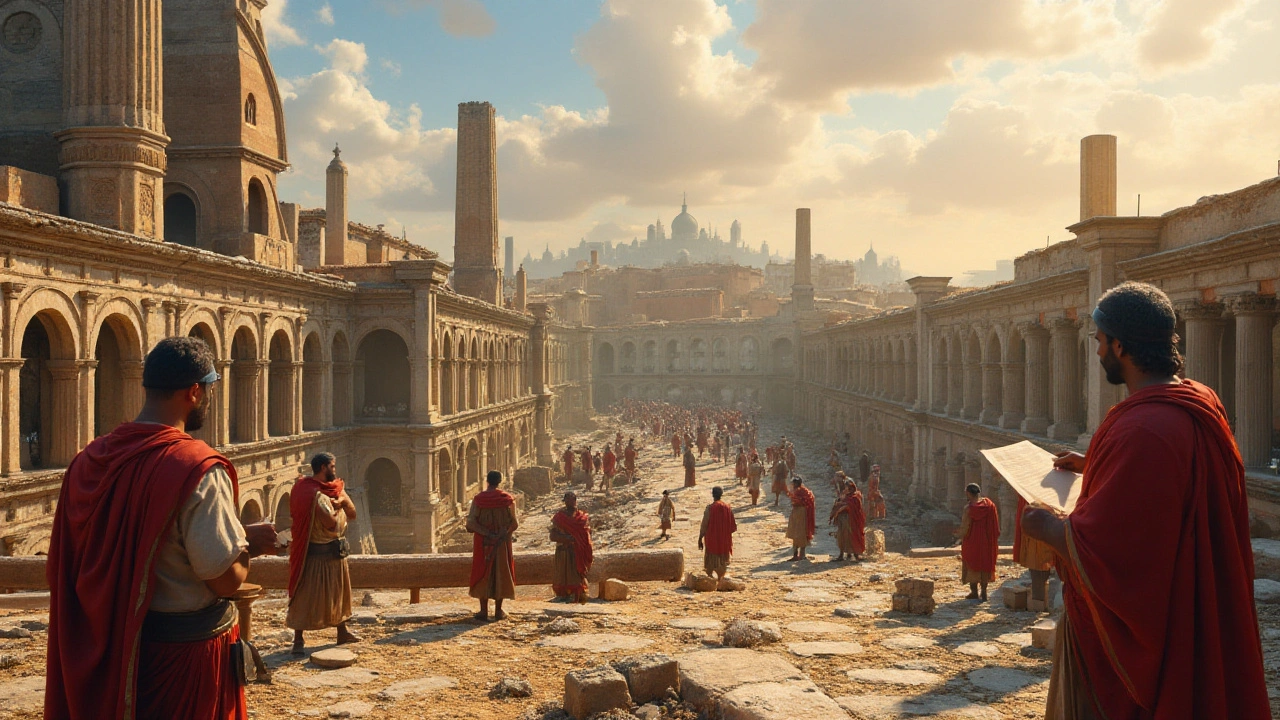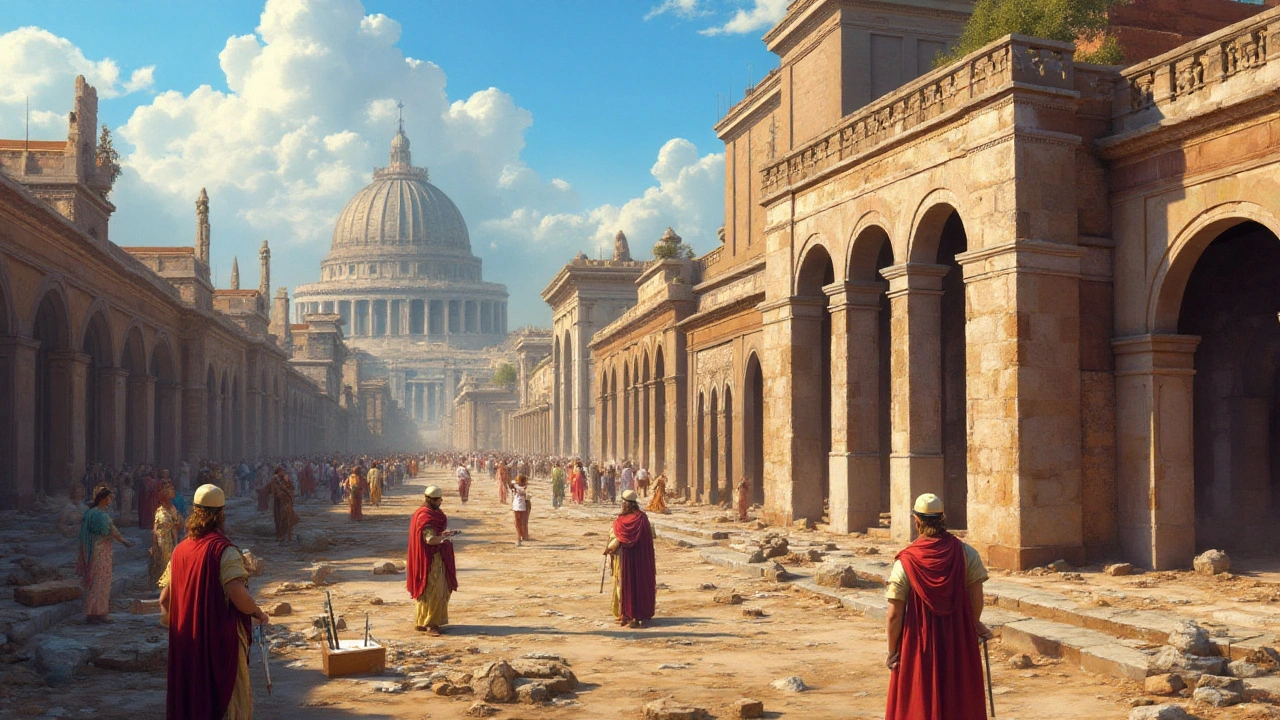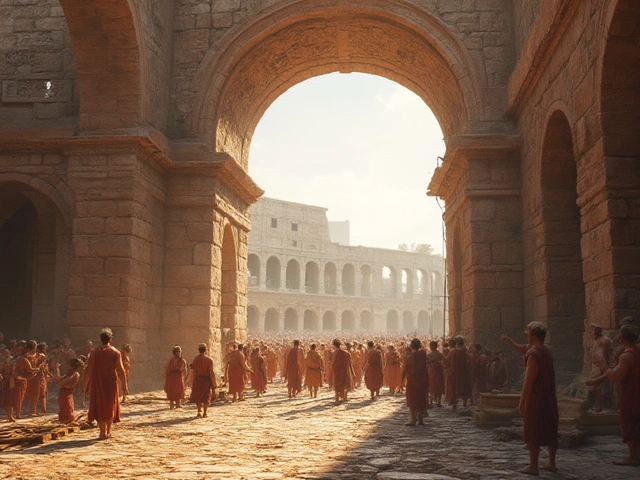Ancient Rome is often celebrated for its vast empire and influential culture, but its architecture holds a special place in history. The Romans were master builders, and their innovations continue to inspire modern architecture. Let's take a journey through the artistic and scientific brilliance of Ancient Roman architecture.
The foundation of Roman architecture was laid with a keen understanding of materials and construction techniques. By mastering the use of concrete, the Romans could create durable structures that could withstand the test of time. They also employed bricks, marble, and other materials, each chosen for its specific properties, to achieve both strength and beauty in their buildings.
- Introduction to Roman Architecture
- Roman Construction Materials and Techniques
- Famous Roman Structures
- Architectural Innovations
- Impact on Modern Architecture
- Preservation and Study
Introduction to Roman Architecture
When we think of Ancient Rome, what often comes to mind are its grand structures. Roman architecture wasn't just about making things big; it was about making them incredible. This is where the mix of Roman engineering and artistic vision really shines. The Romans built temples, amphitheatres, aqueducts, and baths—structures that not only served practical purposes but also showcased the empire's wealth and artistic glory.
What set Roman architecture apart was its use of concrete. By developing a strong and durable form of concrete, the Romans revolutionized building techniques. Before the Romans, concrete was made by mixing limestone and volcanic ash, but the Romans refined this to include broken stones and pieces of brick. This resulted in a material that could harden underwater, making it ideal for constructing harbors and docking facilities.
Their mastery didn't stop at materials. Roman architects designed and implemented advanced infrastructure systems. For instance, the extensive network of aqueducts supplied cities with fresh water. These aqueducts were not just functional but also feats of engineering and aesthetics. The Pont du Gard in France is a striking example. This three-tiered aqueduct is not only huge but also beautifully crafted, demonstrating the Roman focus on form and function.
Another marvel is the Pantheon. This ancient temple, originally built to honor the gods, boasts the world's largest unreinforced concrete dome. With its oculus opening to the sky, the Pantheon invites natural light and invokes a sense of the divine. Visitors today still marvel at its ingenuity and beauty, and it remains a testament to the enduring power of Roman architecture.
Roman public buildings were often adorned with intricate designs and motifs. These elements were not mere ornamentation but had symbolic aspects. For instance, statues of deities and emperors were strategically placed to showcase the divine sanction of Roman rulers. Frescoes, mosaics, and sculptures added color and grandeur, creating an environment that reflected Rome's power and culture.
The Romans also excelled in creating functional spaces. The design of the Roman forum exemplifies this. It was the heart of public life, where politics, commerce, and social activities intertwined. The forum's layout, with its open spaces, basilicas, and public squares, highlights the Romans' sophisticated approach to urban planning.
“Ancient Roman architecture is an extraordinary amalgamation of innovative engineering and sophisticated artistry, and one cannot help but be impressed by its sheer grandeur and enduring influence,” notes Dr. Amanda Claridge, a respected scholar in the field.
Moreover, Roman roads connected the empire like an intricate web. These roads were crucial for trade, military expeditions, and communication across the vast Roman Empire. The saying “all roads lead to Rome” isn't just a metaphor; it highlights the infrastructure's importance in uniting diverse territories.
Roman Construction Materials and Techniques
The ingenuity of Roman architecture is closely tied to the materials and techniques the Romans used. One of the most significant innovations was the development of Roman concrete, or 'opus caementicium.' This material, made from a mixture of lime mortar, volcanic ash, water, and small stones, allowed the Romans to build structures that were not only more durable than those of previous civilizations but also more versatile in terms of design.
Using Roman concrete, engineers could construct massive buildings and infrastructures, like the Pantheon and aqueducts, which have stood the test of time. The volcanic ash in the concrete mix provided the material with an exceptional resistance to water and cracking, enabling it to set underwater, a crucial factor in the Romans' extensive aqueduct systems and harbor installations.
Another material commonly used was brick. Romans perfected the use of fired clay bricks, which offered greater uniformity and stability compared to earlier sun-dried variations. Brick bonds, including the popular 'opus latericium,' were employed to create walls, arches, and vaults that were not only solid but also visually appealing. Marble, too, played a significant role, especially in monumental buildings. The pristine white marble was often used as a façade over concrete structures, lending a majestic and luxurious appearance to temples, forums, and other public edifices.
The Romans were meticulous in selecting and sourcing their construction materials. Stone quarries were established across the empire, notably the marble quarries in Carrara, which provided the exquisite material for numerous grand projects. Timber was another vital resource, primarily used for scaffolding and temporary framework in concrete construction. The Roman's systematic logging strategies ensured a consistent and sustainable supply of this essential material.
The Mastery of Building Techniques
The techniques the Romans applied were just as pioneering as their choice of materials. They developed precise construction methods using forms and molds which supported the creation of complex shapes like domes and vaults. The 'opus testaceum,' a construction technique using flat bricks laid in layers, enabled the rise of structures with great stability and aesthetic value.
According to Vitruvius, a Roman architect and engineer, the principles of 'firmitas, utilitas, and venustas'—strength, utility, and beauty—were integral to Roman architectural philosophy.
The arch, one of Rome's most significant contributions, allowed for the distribution of weight over a broader area, enabling the construction of larger and more durable bridges, aqueducts, and gateways. The keystone at the top of an arch ensured that the various components could support each other, a revolutionary concept that influenced subsequent architectural developments for centuries.
Engineering Marvels
Roman aqueducts, roads, and public baths are further testimony to their engineering prowess. Aqueducts such as Aqua Appia, constructed in 312 BCE, showcased their ability to transport water over great distances using gravity alone. The precision in the gradient ensured a steady, consistent flow, revolutionizing urban water supply systems. Public baths, or 'thermae,' used a combination of innovative heating and water circulation techniques, providing both a social hub and a model of engineering sophistication.
Roman engineering innovations extended beyond monumental constructions. Their road systems, with layers of sand, gravel, and stones, exemplified their mastery of durable and efficient infrastructure. The roads facilitated military movements and trade across the empire, symbolizing the Roman dedication to connecting their vast territories.

Famous Roman Structures
The architectural prowess of the Romans is best appreciated through their famous structures. Each of these buildings signifies not only extraordinary engineering skills but also the artistic vision that defined an era. One of the most iconic structures is the Colosseum, an amphitheater that could hold up to 80,000 spectators. Completed in AD 80, this vast arena hosted gladiatorial contests, animal hunts, and even mock naval battles. Its intricate design with tiered seating, trap doors, and underground passageways showcased the Romans' understanding of crowd control and special effects.
Then there's the Pantheon, a temple dedicated to all the Roman gods, built around 126 AD. Its dome, which remains the world's largest unreinforced concrete dome, is a marvel of engineering. The oculus at the dome's apex serves as a natural light source, illuminating the grand interior. Michelangelo once said, "The Pantheon is the work of angels, not men." Indeed, the Pantheon's harmonious proportions and innovative design continue to influence architects today.
The Roman Forum, the heartbeat of ancient Rome, is another remarkable example. This complex of temples, basilicas, and public spaces was the center of political, religious, and social life. Structures like the Temple of Saturn and the Arch of Titus stand as a testament to the grandeur and significance of the forum. Walking through its ruins, one can almost hear the echoes of ancient debates, religious ceremonies, and bustling markets.
Aqueducts are another remarkable achievement. The aqueduct system, with its series of pipes, tunnels, and bridges, brought fresh water from distant sources into the cities. The Aqua Appia, completed in 312 BC, was Rome's first aqueduct. It set the standard for subsequent constructions, ensuring a reliable water supply for public baths, fountains, and private households. The Aqua Claudia and the Anio Novus, two of the grandest, stretched over 50 miles. This network not only showcased the Romans' engineering skills but also improved the urban quality of life.
The Baths of Caracalla, completed in AD 216, were one of the largest and most opulent public baths in ancient Rome. Covering over 33 acres, they could accommodate up to 1,600 visitors at a time. The complex included hot and cold baths, swimming pools, libraries, and gardens. Its grand halls, adorned with marble and mosaics, exemplified the luxury and sophistication of Roman society. The Romans understood the importance of public baths in fostering community and promoting hygiene.
Lastly, the Roman roads, which stretched over 250,000 miles at the empire's peak, are a testament to the Romans’ engineering prowess. The Appian Way, Rome's first major road, was built in 312 BC to connect Rome to southern Italy. These roads were meticulously constructed with layers of sand, gravel, and stone, ensuring durability and facilitating military movements, trade, and communication. Their design was so effective that many Roman roads remain in use today.
In conclusion, the famous structures of ancient Rome reflect a civilization that valued innovation, aesthetics, and practicality. These marvels of engineering and artistry continue to inspire awe and admiration, standing as enduring monuments to one of history's greatest empires.
Architectural Innovations
The Romans were known for their remarkable architectural innovations. One of the standout innovations was the development and extensive use of concrete. This allowed them to build structures that were not only incredibly strong but also complex and varied in design. It was this material that made the construction of large-scale buildings like the Pantheon and aqueducts possible. With concrete, they could shape their architectural dreams into reality with unparalleled precision and longevity.
Another significant Roman invention was the arch. The use of arches in structures like the Colosseum allowed for greater spans and the ability to support more weight than traditional post and lintel construction methods. This innovation led to the development of the vault and dome, which are key elements in many Roman buildings. The impressive engineering feats of structures such as the Basilica of Maxentius and the Baths of Caracalla demonstrate the advanced understanding of geometry and physics that the Romans possessed.
The Romans also revolutionized the use of civic space with their architectural designs. The Forum, for example, served not just as a marketplace but also as the center of political and social life. These public spaces were meticulously planned and executed to facilitate the day-to-day activities of Roman citizens. They incorporated temples, basilicas, and open spaces to create a multifaceted environment that was both functional and aesthetically pleasing.
One cannot discuss Roman architecture without mentioning the aqueducts. These marvels of engineering were essential for supplying water to their cities. The Romans designed and constructed aqueducts with remarkable precision, ensuring a steady flow of water across vast distances. The Aqua Appia, built in 312 BC, was the first of many and showcased the Romans' ability to overcome geographical challenges through innovation and practical engineering solutions.
"The ancient Romans were builders of unparalleled skill and their architectural principles continue to be the backbone of modern construction practices." — Robert MacGinnis, Architectural Historian
The integration of urban planning into their architectural practices was another Roman innovation. The grid-based layout of Roman towns and cities allowed for systematic growth and organization. This practice is evident in the remnants of towns like Pompeii and the city of Timgad in Algeria. The Roman approach to city planning included provisions for public spaces, residential areas, and even sanitation, which highlights their comprehensive understanding of urban living.
Lastly, the Romans were pioneers in the development of durable road systems. Roman roads were engineered with several layers of materials to provide stability and drainage. These roads were crucial for the movement of troops, trade, and communication across the empire. The Roman road network spanned approximately 400,000 kilometers, with around 80,500 kilometers being stone-paved. This immense infrastructure facilitated not just travel and trade but also the spread of Roman culture and influence throughout the known world.

Impact on Modern Architecture
The influence of Ancient Roman architecture is deeply embedded in modern design. Many contemporary structures echo Roman ingenuity in their stability and grandeur. Take, for example, the widespread use of columns and arches, which are direct descendants of Roman architectural elements. Arches, in particular, distribute weight more evenly and allow for the construction of larger and more durable buildings. The Romans perfected the technique, and today, arch-based structures are both a practical and aesthetic choice in architecture.
Roman architectural principles also laid the groundwork for the development of the modern city. Their use of urban planning, grid systems, and expansive road networks created a framework that is still applied in city designs worldwide. Rome's efficient roadways and aqueducts demonstrated the value of well-planned infrastructure. These principles are mirrored in the advanced public works projects we see in today's metropolitan areas.
The construction materials introduced by the Romans, especially concrete, have fundamentally shaped the architectural world. Roman concrete was a revolutionary building material, highly durable and versatile. Modern builders often rely on reinforced concrete for its similar properties. The blend may differ, but the practicality remains. This influence is so significant that some of the world's most iconic landmarks, such as the Pantheon in Rome, have stood for millennia thanks to Roman concrete.
Another significant facet is the Roman emphasis on aesthetics combined with functionality. Buildings like the Colosseum not only served a purpose but were also masterpieces of design. Modern sports arenas and public buildings often draw inspiration from the multi-use and highly accessible features of Roman structures. The open spaces, tiered seating, and grand facades are examples of how ancient design concepts are utilized in today's constructions.
Roman architectural influence can be seen across various continents. In the United States, for example, many government buildings like the Capitol in Washington, D.C., showcase Roman columns and domes. This style, known as neoclassicism, emphasizes simplicity and grandeur and finds its roots in Roman architecture. Both the Library of Congress and the National Archives are excellent examples.
"The willingness of Rome to borrow architectural techniques and forms from the cultures they integrated into the empire has led to a rich and eclectic architectural legacy," says Amanda Claridge, a professor of archaeology and ancient history.
In modern architecture, preservation of these ancient masterpieces offers vital insights into the past. Technologies and methods used in the restoration of Roman structures have significantly contributed to contemporary conservation techniques. For instance, laser scanning and 3D modeling originally developed for ancient sites are now used extensively in preserving all sorts of historical buildings across the world.
In essence, the Romans were ahead of their time, and their architectural philosophy continues to be a guiding beacon in contemporary design. From materials and techniques to city planning and aesthetic principles, the impact of Ancient Roman architecture is vast and timeless. As we continue to build the cities of the future, it is clear that the Romans' ancient wisdom still plays a crucial role in shaping our built environment.
Preservation and Study
Ancient Roman architecture has fascinated historians, archaeologists, and tourists alike for centuries. Preserving these magnificent structures is a complex task that requires a blend of modern science and old-world techniques. Many Roman buildings, like the Pantheon and the Colosseum, have been standing for nearly two millennia, a testament to their exceptional construction methods and the enduring quality of their materials.
The process of preserving Roman architecture often begins with detailed documentation. Archaeologists and historians create meticulous records of each structure, capturing its current state and noting any degradation or damage. This involves a combination of photography, 3D scanning, and traditional drawing methods. These records are essential for planning restoration projects and for academic study.
One major factor in the preservation of Roman architecture is the choice of materials. The Romans used a type of concrete that has proven incredibly durable over the centuries. This ancient concrete is made from volcanic ash, lime, and seawater, which together create a chemical reaction that strengthens the material over time. Modern scientists study this ancient formula to improve contemporary construction materials, hoping to replicate the remarkable longevity of Roman concrete.
Restoration projects also play a crucial role in preserving Roman architecture. These projects often involve cleaning, repairing, and sometimes reconstructing parts of these ancient structures. For example, the Colosseum undergoes regular cleaning to remove dirt and pollutants that can cause damage to the stone over time. This work requires a great deal of skill and knowledge to ensure that the restoration is as accurate and respectful to the original construction as possible.
The study of ancient Roman architecture is an ongoing field, with new discoveries and insights emerging each year. Scholars examine ruins, inscriptions, and ancient texts to piece together a comprehensive understanding of Roman building practices. This research not only helps with preservation efforts but also provides valuable lessons for modern architects and engineers.
A fascinating aspect of Roman architectural study is the insight it provides into Roman society and culture. The grandeur of their buildings reflects the values and ambitions of the Roman Empire. Structures like the aqueducts and amphitheaters highlight their advanced engineering skills and their commitment to public welfare and entertainment. By studying these buildings, we gain a deeper understanding of Roman life and achievements.
As technology advances, the methods used to preserve and study Roman architecture continue to evolve. Drones, for example, are now used to survey large archaeological sites, providing high-resolution images and data that were previously unattainable. Similarly, advancements in materials science offer new ways to protect and maintain these ancient structures, ensuring they remain standing for future generations to appreciate.
“The architectural legacy of Rome is not just about preserving stones and bricks; it’s about understanding the human spirit that built them.” — John Rickman, Historian
Efforts to preserve and study Roman architecture are more than just attempts to keep old buildings intact. They are endeavors to safeguard a vital part of our shared human heritage. By continuing to explore and protect these ancient marvels, we honor the ingenuity and artistry of the Roman builders, ensuring that their contributions to world culture endure.




